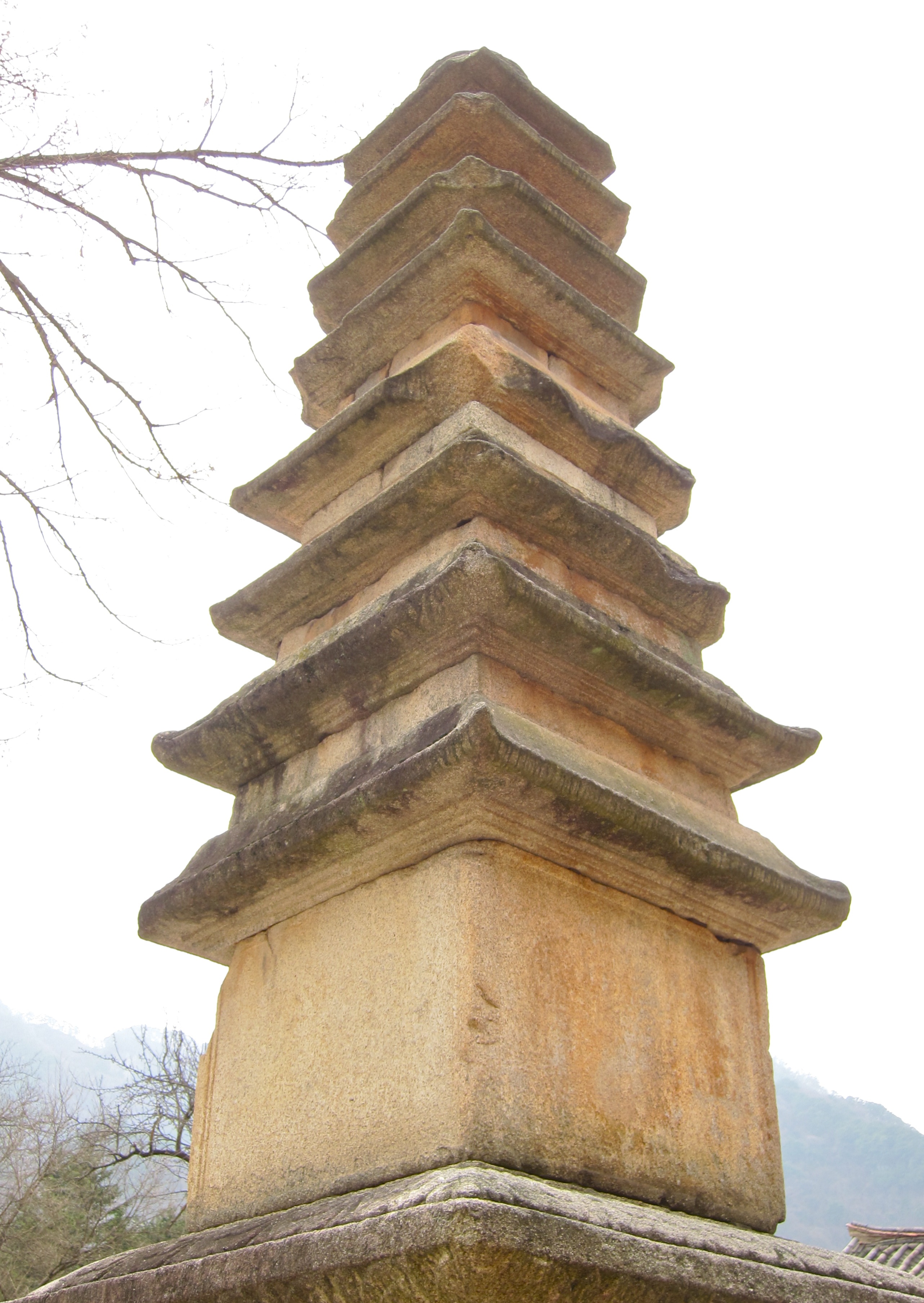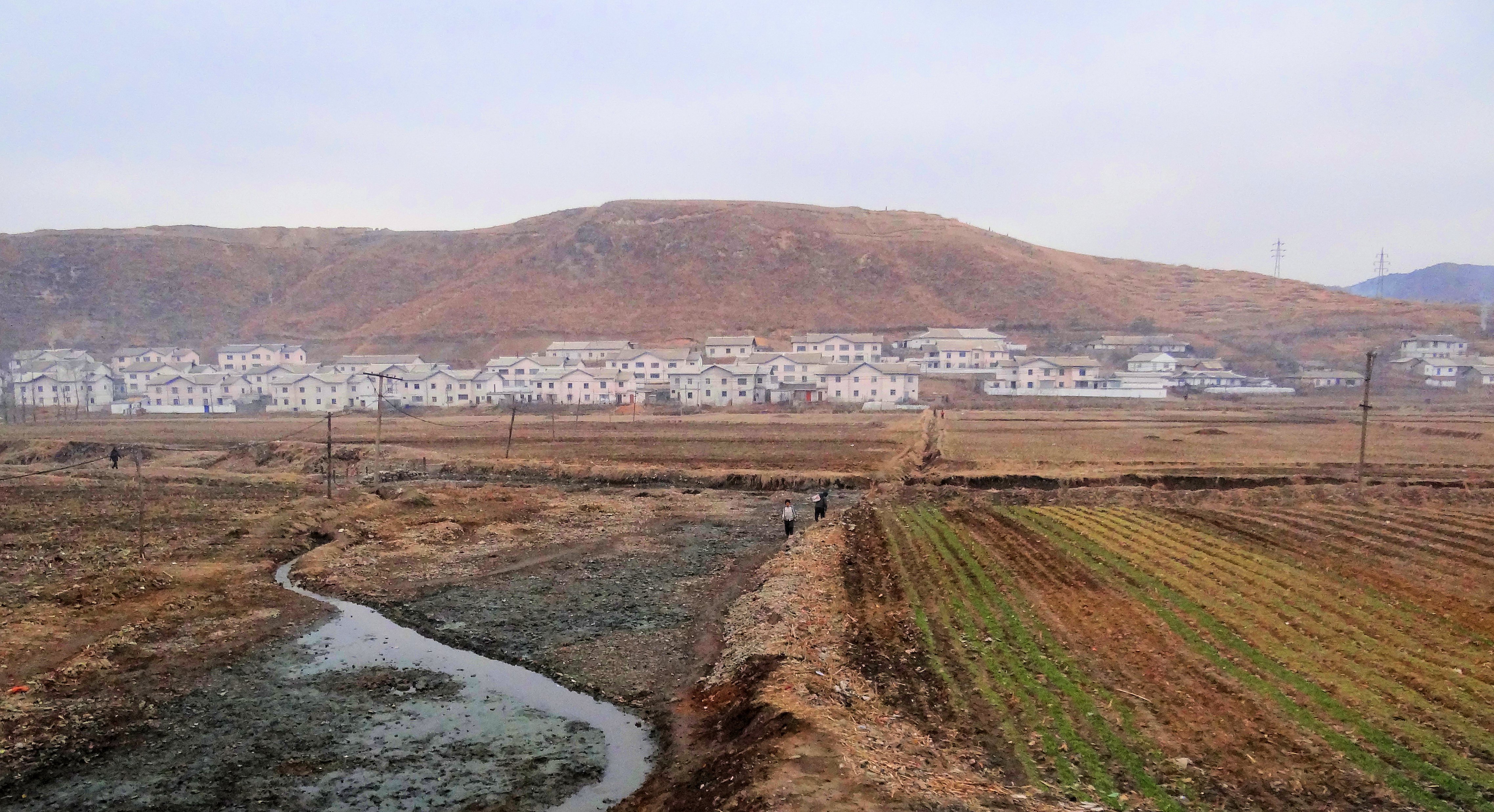|
Anguksa
Anguk-sa is a Korean Buddhist temple situated in Pyongsong, South Pyongan Province, North Korea. Built on the slopes of Mt. Pongrin, the temple dates to the Koryo dynasty, though all of the buildings date to later Joseon dynasty renovations. The building is registered as National Treasure #34. History Anguk Temple was founded in 503 under Koguryo Goguryeo (37 BC–668 AD) ( ) also called Goryeo (), was a Korean kingdom located in the northern and central parts of the Korean Peninsula and the southern and central parts of Northeast China. At its peak of power, Goguryeo controlled most .... It was later reconstructed in 1419, and again renovated in 1785 under king Chŏngjo. Architecture The temple has a linear layout. Through the temple's front gate is the outer court, with a monument to the temple's construction and a 9-tiered pagoda dating to the original Koryo temple. The ginkgo tree located in this yard was planted around 1400, and is listed as Living Monument #31 ... [...More Info...] [...Related Items...] OR: [Wikipedia] [Google] [Baidu] |
Korean Buddhist Temple
Buddhist temples are an important part of the Korean landscape. This article gives a brief overview of Korean Buddhism, then describes some of the more important temples in Korea. Most Korean temples have names ending in ''-sa'' (사, 寺), which means "temple" in Sino-Korean. Many temples, like Sudeoksa, offer visitors a Temple Stay program. Background A distinctive form of Buddhism evolved in Korea. This was facilitated by the geographical location and cultural conditions. Buddhism first arrived in Korea in 372 in Goguryeo. In 374 the influential Han Chinese monk Ado arrived in the kingdom and inspired King Sosurim of Goguryeo the following year. The first two temples Seongmunsa and Ilbullansa were built in 375 on the order of the king. Buddhism soon became the national religion of Goguryeo. With the advent of Taoism in 624 the rulers began to suppress Buddhism and its importance quickly declined. The Baekje Kingdom, on the other hand, flourished under the influence of Bud ... [...More Info...] [...Related Items...] OR: [Wikipedia] [Google] [Baidu] |
National Treasures Of North Korea
A National Treasure (국보; 國寶 : ) is a tangible artifact, site, or building deemed by the Government of North Korea to have significant historical or artistic value to the country. History The first list of Korean cultural treasures was designated by Governor-General of Korea in 1938 during the Japanese occupation with "The Act of Treasures of the Joseon dynasty". Nos. 1-50 Nos. 51-100 Nos. 101-150 Nos. 151-193 See also * Cultural assets of North Korea * Natural monuments of North Korea * National Treasure (South Korea) * Complex of Koguryo Tombs * History of Korea * Culture of Korea The traditional culture of Korea is the shared cultural and historical heritage of Korea and southern Manchuria before the division of Korea in 1945. Manchuria refers to the ancient geographical and historical region in Northeast Asia, includ ... * List of World Heritage Sites in Asia#North Korea (1) Footnotes {{reflist References * http://www.kcpia.or.kr/kcpia_mail/mail_tem ... [...More Info...] [...Related Items...] OR: [Wikipedia] [Google] [Baidu] |
Natural Monuments Of North Korea
Natural monuments of North Korea is a natural monuments system that designates natural resources that are designated as significant to the North korean government. A total of 469 natural monument entries have been designated from no.1 to no. 935. History Designation standards The designations are not only considered in a academic,aesthetic and economic perspective, but also designated based on whether it has significant revolutionary history regarding the ruling Kim family of north korea.For plants it can be something the Kim family planted themselves, for geology it can be things that they named themselves, or important in terms of cult of peronality, such as Mount Paektu and Samjiyon lake, for animals it can be things that were paid attention to by the Kim family. List No. 1 - 50 Missing numbers are simply numbers that are not designated with natural monuments. 50-100 Missing numbers are simply numbers that are not designated with natural monuments. No. 10 ... [...More Info...] [...Related Items...] OR: [Wikipedia] [Google] [Baidu] |
Pyongsong
Pyongsong (, , officially Phyongsong) is a city in North Korea, the capital city of South Pyongan province in western North Korea. The city is located about 32 kilometres northeast of Pyongyang, and was formally established in December 1969. It has a population of 284,386.Central Bureau of Statistics, Pyongyang, DPR Korea; 2008 Population Census, National Report (pdf-fil) Läst 17 januari 2010. History The area that is now Pyongsong was formerly and |
South Pyongan
South Pyongan Province (Phyŏngannamdo; ) is a province of North Korea. The province was formed in 1896 from the southern half of the former Pyongan Province, remained a province of Korea until 1945, then became a province of North Korea. Its capital is Pyongsong. Geography The province is bordered by North Pyongan and Chagang Provinces to the north, South Hamgyong and Kangwon Provinces to the east and southeast and North Hwanghae Province and Pyongyang to the south. The Yellow Sea and Korea Bay are located to the west. Administrative divisions South P'yŏngan is divided into 1 special city (''tŭkpyŏlsi''); 5 cities (''si''); 16 counties (''kun''); and 3 districts (1 ''ku'' and 2 ''chigu''). Its administrative divisions are: Cities * Nampo Special City (남포특별시/; created in 2010) * Pyongsong (평성시/; the provincial capital, established December 1969) * Anju (안주시/; established August 1987) * Kaechon (개천시/; established August 1990) * Sunchon-si (순� ... [...More Info...] [...Related Items...] OR: [Wikipedia] [Google] [Baidu] |
North Korea
North Korea, officially the Democratic People's Republic of Korea (DPRK), is a country in East Asia. It constitutes the northern half of the Korea, Korean Peninsula and shares borders with China and Russia to the north, at the Yalu River, Yalu (Amnok) and Tumen River, Tumen rivers, and South Korea to the south at the Korean Demilitarized Zone. North Korea's border with South Korea is a disputed border as both countries claim the entirety of the Korean Peninsula. The country's western border is formed by the Yellow Sea, while its eastern border is defined by the Sea of Japan. North Korea, like South Korea, its southern counterpart, claims to be the legitimate government of the entire peninsula and List of islands of North Korea, adjacent islands. Pyongyang is the capital and largest city. In 1910, Korean Empire, Korea was Korea under Japanese rule, annexed by the Empire of Japan. In 1945, after the Surrender of Japan, Japanese surrender at the End of World War II in Asia, end ... [...More Info...] [...Related Items...] OR: [Wikipedia] [Google] [Baidu] |
Goryeo
Goryeo (; ) was a Korean kingdom founded in 918, during a time of national division called the Later Three Kingdoms period, that unified and ruled the Korean Peninsula until 1392. Goryeo achieved what has been called a "true national unification" by Korean historians as it not only unified the Later Three Kingdoms but also incorporated much of the ruling class of the northern kingdom of Balhae, who had origins in Goguryeo of the earlier Three Kingdoms of Korea. The name "Korea" is derived from the name of Goryeo, also spelled Koryŏ, which was first used in the early 5th century by Goguryeo. According to Korean historians, it was during the Goryeo period that the individual identities of Goguryeo, Baekje, and Silla were successfully merged into a single entity that became the basis of modern-day 'Korean' identity. Throughout its existence, Goryeo, alongside Unified Silla, was known to be the "Golden Age of Buddhism" in Korea. As the state religion, Buddhism achieved its highes ... [...More Info...] [...Related Items...] OR: [Wikipedia] [Google] [Baidu] |
Joseon Dynasty
Joseon (; ; Middle Korean: 됴ᇢ〯션〮 Dyǒw syéon or 됴ᇢ〯션〯 Dyǒw syěon), officially the Great Joseon (; ), was the last dynastic kingdom of Korea, lasting just over 500 years. It was founded by Yi Seong-gye in July 1392 and replaced by the Korean Empire in October 1897. The kingdom was founded following the aftermath of the overthrow of Goryeo in what is today the city of Kaesong. Early on, Korea was retitled and the capital was relocated to modern-day Seoul. The kingdom's northernmost borders were expanded to the natural boundaries at the rivers of Amrok and Tuman through the subjugation of the Jurchens. During its 500-year duration, Joseon encouraged the entrenchment of Confucian ideals and doctrines in Korean society. Neo-Confucianism was installed as the new state's ideology. Buddhism was accordingly discouraged, and occasionally the practitioners faced persecutions. Joseon consolidated its effective rule over the territory of current Korea and saw the ... [...More Info...] [...Related Items...] OR: [Wikipedia] [Google] [Baidu] |
Koguryo
Goguryeo (37 BC–668 AD) ( ) also called Goryeo (), was a Korean kingdom located in the northern and central parts of the Korean Peninsula and the southern and central parts of Northeast China. At its peak of power, Goguryeo controlled most of the Korean peninsula, large parts of Manchuria and parts of eastern Mongolia and Inner Mongolia. Along with Baekje and Silla, Goguryeo was one of the Three Kingdoms of Korea. It was an active participant in the power struggle for control of the Korean peninsula and was also associated with the foreign affairs of neighboring polities in China and Japan. The ''Samguk sagi'', a 12th-century text from Goryeo, indicates that Goguryeo was founded in 37 BC by Jumong (), a prince from Buyeo, who was enthroned as Dongmyeong. Goguryeo was one of the great powers in East Asia, until its defeat by a Silla–Tang alliance in 668 after prolonged exhaustion and internal strife caused by the death of Yeon Gaesomun (). After its fall, its territory w ... [...More Info...] [...Related Items...] OR: [Wikipedia] [Google] [Baidu] |
Jeongjo Of Joseon
Jeongjo of Joseon (28 October 1752 – 18 August 1800), personal name Yi San (Korean: 이산; Hanja: 李祘), sometimes called Jeongjo the Great (Korean: 정조대왕; Hanja: 正祖大王), was the 22nd monarch of the Joseon dynasty of Korea. After succeeding his grandfather, King Yeongjo, he made various attempts to reform and improve the nation. Biography Early life He was the son of Crown Prince Sado (who was put to death by his own father, King Yeongjo) and Lady Hyegyeong (who wrote an autobiography, '' The Memoirs of Lady Hyegyeong'' detailing her life as the ill-fated Crown Princess of Korea). His elder brother Crown Prince Uiso died in infancy. His mother Lady Hyegyeong's collection of memoirs serves as a significant source of historical information on the political happenings during the reigns of King Yeongjo (her father-in-law), King Jeongjo (her son), and King Sunjo (her grandson). In 1762, his father, Crown Prince Sado, was executed by King Yeongjo (Crown Prince Sa ... [...More Info...] [...Related Items...] OR: [Wikipedia] [Google] [Baidu] |
Ginkgo
''Ginkgo'' is a genus of non-flowering seed plants. The scientific name is also used as the English name. The order to which it belongs, Ginkgoales, first appeared in the Permian, 270 million years ago, and is now the only living genus within the order. The rate of evolution within the genus has been slow, and almost all its species had become extinct by the end of the Pliocene. The sole surviving species, ''Ginkgo biloba'' is only found in the wild in China, but is cultivated around the world. The relationships between ginkgos and other groups of plants are not fully resolved. Prehistory The ginkgo (''Ginkgo biloba'') is a living fossil, with fossils similar to the modern plant dating back to the Permian, 270 million years ago. The closest living relatives of the clade are the cycads, which share with the extant ''G. biloba'' the characteristic of motile sperm. The ginkgo and cycad lineages are thought to have an extremely ancient divergence dating to the early Ca ... [...More Info...] [...Related Items...] OR: [Wikipedia] [Google] [Baidu] |






